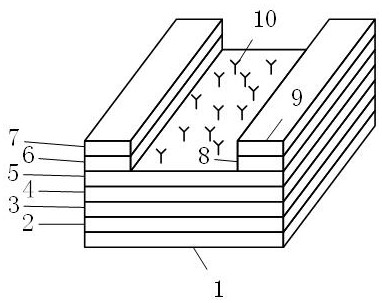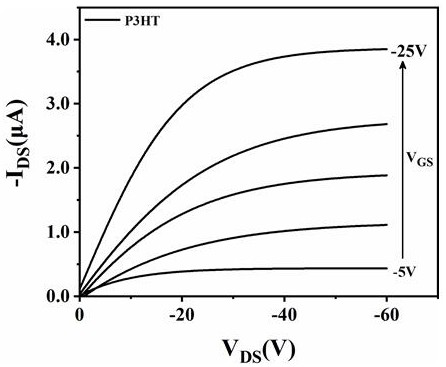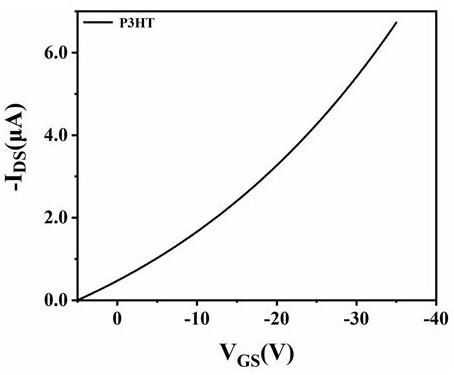Thin film transistor for ultralow-limit detection of C-reactive protein and preparation method thereof
A technology of thin film transistors and reactive proteins, which is applied in the field of biosensors, can solve the problems of high detection limit of C-reactive protein, and achieve the effects of preventing leakage, low cost, and saving preparation time
- Summary
- Abstract
- Description
- Claims
- Application Information
AI Technical Summary
Problems solved by technology
Method used
Image
Examples
Embodiment 1
[0034] A preparation method of a thin film transistor for ultra-low limit detection of C-reactive protein, specifically comprising the following steps:
[0035] 1) Substrate treatment: The PET / ITO film is fixed on the glass sheet, and the oxygen plasma hydrophilic treatment is performed for 1 min; wherein, the glass sheet is the substrate 1, and the PET / ITO film is the gate 2.
[0036] 2) Active layer material: drop 500 μl of a PVA aqueous solution with a concentration of 15 mg / ml on the gate electrode 2 , and naturally cure for 12 hours to form the PVA insulating layer 3 . After annealing in a 60° C. oven for 2 hours, drop-coating 500 μl of a PMMA anisole solution with a concentration of 5 mg / ml, and annealing in a 90° C. oven for 30 minutes to form a PMMA insulating layer 4 .
[0037] 3) Spin-coating of active layer: spin-coat 8mg / ml P3HT-dichlorobenzene solution on PVA / PMMA at 2000r / min, and anneal on a hot plate at 120°C for 10min to form active layer 5 .
[0038] 4) Sour...
Embodiment 2
[0043] The sensors prepared in Example 1 were placed in 5pM, 50pM, 5×10 2 pM, 5×10 3 pM, 5×10 4 pM, 5×10 5 pM, 5×10 6The transfer curve obtained in pM CRP solution is as Image 6 shown. In the figure it can be seen that there is still a significant current change at CRP concentrations as low as 5 pM.
PUM
| Property | Measurement | Unit |
|---|---|---|
| concentration | aaaaa | aaaaa |
| concentration | aaaaa | aaaaa |
Abstract
Description
Claims
Application Information
 Login to View More
Login to View More - R&D Engineer
- R&D Manager
- IP Professional
- Industry Leading Data Capabilities
- Powerful AI technology
- Patent DNA Extraction
Browse by: Latest US Patents, China's latest patents, Technical Efficacy Thesaurus, Application Domain, Technology Topic, Popular Technical Reports.
© 2024 PatSnap. All rights reserved.Legal|Privacy policy|Modern Slavery Act Transparency Statement|Sitemap|About US| Contact US: help@patsnap.com










